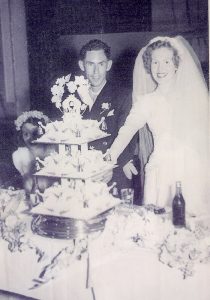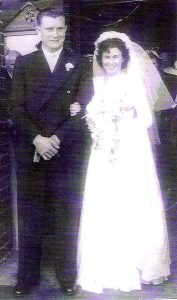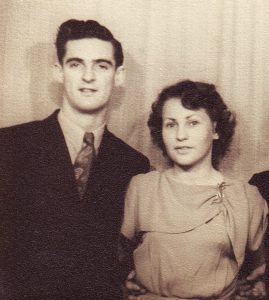10 minute read
Almost 75 years ago, five friends gathered at their local dance hall to have their photograph taken. The year was 1949 and the young girls were having the time of their lives. World War II had ended a few years previously and the world around them was a more optimistic place than it had ever been in their lifetime. Today’s blog tells the story of three of these dance hall girls, two of them my great aunts. I was lucky enough to know them and I can attest to the fact they were just as much fun in their older years as they were in this photograph. I’ve long loved this photograph for what it represents and the way it makes me smile whenever I see it.
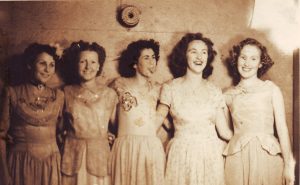
Beryl Poulter, my youngest great aunt, on the left was born in July 1928 in Sydney’s Eastern Suburbs. She was the great aunt we stayed with when my family visited Clovelly in the 1970s and 1980s. She instilled a love of Sydney in me that has never wavered. Revelling in the limelight in the centre of the photograph is Beryl’s older sister Mavis, born in December 1926. Mavis’ cheeky side was inherited from her father Bert. I only got to her know her better in the decade before her death and I was privileged to be with her on the day she took her last breath.
Between Beryl and Mavis is Mavis’ friend Pat, who would become her bridesmaid and lifelong friend. On the far right of the photograph is Rose O’Grady, a young lass who would become Mavis and Beryl’s sister-in-law. I have no name for the lass next to Rose, though no doubt she was also a treasured friend to all. Born in the mid to late 1920s, these girls were from what became known as the Greatest Generation. They came into the world a decade after WW1 had finished and just before the Great Depression hit. Only small children when the Depression broke in 1929, these women would spend their childhood often deprived of the basic necessities like food and clothing. For Beryl, Mavis, their five siblings and parents, money was so tight they frequently made use of the soup kitchens, with the elder children walking many blocks home with this critical sustenance for the whole family. Birthday and Christmas presents were limited to practical items like shoes. They spent their childhood living life in the simplest of ways and were grateful for every precious moment. They saw their fathers, uncles and brothers out of work regularly and the effect that the Great War had on those who had served overseas.
Mavis and Beryl saw the deep loss their mother Eileen felt after her brother Maurice Quirk was killed on the battlefields of France in 1918. They saw the aftereffects of the gas poisoning that ruined their Uncle Mick’s lungs. Rose O’Grady also lived with the aftereffects of the Great War in her household. Her father Jim O’Grady had served in WW1 and been wounded three times. First felled by a gun shot wound to the chest, he recovered only to be sent to the Western Front again, where he inhaled poisonous gas and was repatriated to England a second time. His third time back to the Front ended his war experience and he was lucky to return home alive.
As the girls grew older and hit their late teens, they saw their older brothers, cousins, friends and fathers leave to serve Australia’s interests in another war with Germany and later Japan. When declared in September 1939, Beryl, Mavis and Rose were old enough to understand the toll this second war would take on their parents. For Eileen Poulter, 1941 saw her eldest son Billy enlist and spend time fighting in New Guinea. Many other young men, just a little older than the girls, would enlist, leaving another generation of women fearing the loss of potential future hsubands. To add to the heartache, Mavis and Beryl’s older brother Charlie left the family home to find work in the bush and their other brother Mitta became very ill with heart disease, the legacy of a childhood rheumatic fever illness. On the night a Japanese submarine made its way into Sydney Harbour, Mitta succumbed to his illness, plunging the family into grief.
I used to visit my Great Aunty Joyce, Mavis and Beryl’s sister, then in her 80s, and ask about those tough depression years and the war years. I was surprised when she did not hesitate to nominate the War years as more difficult. Not only did she worry about her brother in New Guinea, but once again it had become a battle to secure the basic necessities. Whilst in the Depression years you could buy what you needed, provided you had the money, during the war many items were rationed. It didn’t matter how much money you had, for if you didn’t have the adequate number of coupons, you couldn’t buy what you needed. Every family had the same amount of ration coupons, so everyone was equal. The war became the great leveller.
This system of rationing was introduced in 1942, restricting the ability to buy meat, butter, tea and sugar as well as clothing. Each adult was allocated 112 clothing coupons per year. To buy a dress you needed 12 coupons, some 10% of a yearly allotment. Each pair of stockings cost 4 coupons. For a young lady to buy an outfit of a frock, an overcoat, a pair of stockings and a pair of shoes to go dancing would use half of her annual coupons. In comparison to the dance hall girls photograph, a street photograph of Mavis and Beryl, taken around 1942-43 shows the relative simplicity of rationed clothing. Always one to make a statement however, it may have taken quite a few coupons to buy the pretty white shoes Mavis has on, if indeed they were not pre-war bought shoes.
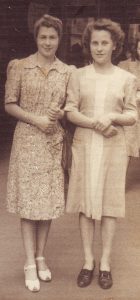
During the war years, both Mavis and Beryl left school to go to work. Beryl went to technical school to learn secretarial skills, including shorthand. She soon found work in a city office as a stenographer, earning her own money and creating a sense of independent identity, the essence of which still lingered when I knew her as a teenager. Beryl had benefited from the NSW government decision in 1940 to raise the school leaving age to fifteen, ensuring that she received more education than her elder siblings did. Rose also found office work, earning herself a decent wage, which no doubt she used to help support her family. Mavis was passionate about dancing and taught other young ladies to dance. She once told me she mastered all the popular dances of the day, including ballroom favourites, the Quickstep, Foxtrot, Waltz, Tango and the Latin inspired Jive.
After paying board to their parents, the girls were left with a little money to spend on social activities. To get to and from the dance halls, a network of trams criss-crossed the Eastern Suburbs. Mavis and Beryl lived at 19 Winchester Road in Clovelly, a four mile journey from Rose O’Grady’s house at 231 Bunnerong Road, Pagewood. The journey to each other’s house was an hour’s walk or two separate tram rides. Apart from local dance halls, larger venues in the city may have also attracted the girls, including the popular Sydney Trocadero. This venue showcased the Big Band musicians where up to 2000 dancers could enjoy an evening of lively entertainment. With their city clerk salaries, Beryl and Rose were also well placed to meet gentleman in their offices and enjoy a social life before the responsibilities of marriage came along.
Once the war had ended, rationing did not ease, as essentials were still in short supply. An article from the Sydney Morning Herald of December 1946 detailed changes to the coupon scheme. ‘Only 56 clothing coupons will be available for the next 12 months. Coats for women – 6 coupons. Nightdress – 11 coupons. Blouse – 4 coupons.’ Another article from The Sydney Morning Herald in 1947 describes some of the rationing obstacles facing those who attended dance balls. ‘A few more glamour fabrics have been available this season, and intensive search has been rewarded by limited lengths of brocade, taffeta and marquisette. Lightweight woollen fabrics, which drape well and can be embroided with beads, sequins, silk or woollen thread, have been used to make dance dresses and dinner gowns for cooler nights. The majority of ball committees have realised that it is still difficult to obtain men’s evening wear and have decided to permit lounge suits to be worn. Despite their rapidly diminishing coupons, women will be expected, however, to appear in evening dress at all night festivities this year.’
You can imagine Beryl, Mavis and Rose’s excitement when rationing was abandoned in June 1948, some three years after the war had ended. Now well placed to dress in their finest and finally throw off the shadows of war, Mavis, Beryl and Rose were living life to the fullest by 1949. Another photograph taken on the same night shows Rose with her future husband Bertie Poulter, Mavis dating a young gentleman (name unknown) and John, Mavis’s future husband, dating her friend. Not long afterwards, Mavis’ cheeky and vivacious personality won John over. Life was good. Their brother were back home safe from war, essential supplies had been restored and the girls had more independence than any generation of women before them.
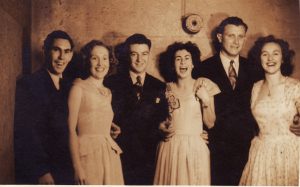
In November 1949, Rose married Bertie Poulter and he, being a baker, made the most extraordinary three-tiered fruit cake tower decorated with bells and slippers. The couple ran a bakery together and had one son before divorcing in the 1960s. Mavis married John Smith in February 1950. They had six children and lived for many years in Stanmore. Their marriage lasted 60 years before John’s death. Beryl married Robert (Bob) Connor, also in 1950, with the marriage producing one son. Beryl’s death in 1989 ended just 39 years of marriage. Mavis and Beryl’s close relationship would continue throughout their lives. They retained their cheeky sense of humour and as their great niece, I found them both to be great fun. They never took themselves too seriously. I only wish I’d had more time with them and heard more of the stories of their golden Dance Hall Days.
